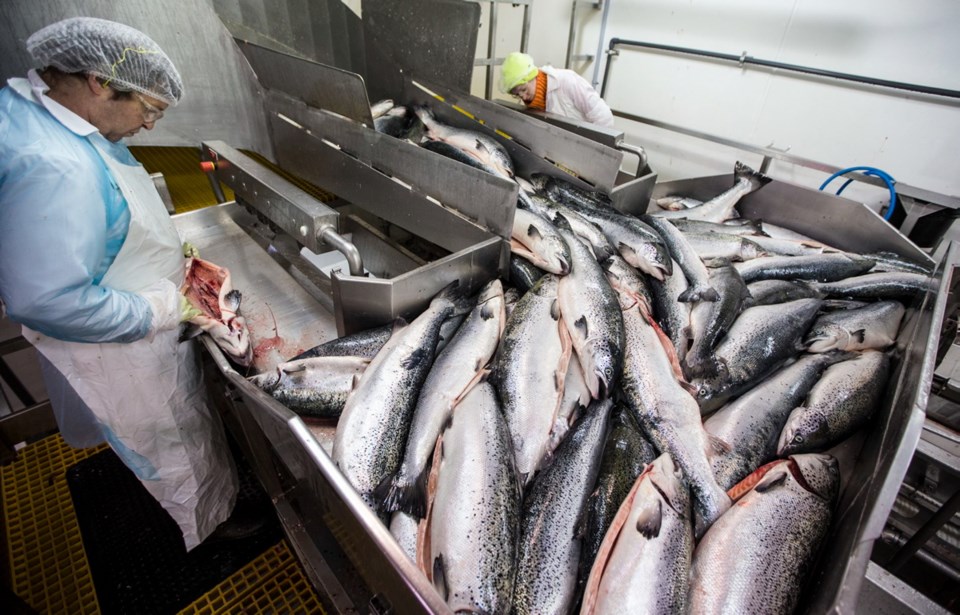If the federal Liberals are able to follow through on their pledge to switch the B.C. salmon aquaculture industry to closed containment by 2025, the industry would collapse, salmon farmers say.
“This will shut the industry down and it will take all those jobs in remote communities with it, end of story” said Cermaq Canada managing director David Kiemele.
B.C.’s industry is based on a hybrid system in which smolts are grown in land-based facilities and then finished in more natural conditions in ocean-based net pens.
The announcement sent a shock wave up along the coast.
“We just didn’t see this coming based on all the work that has been done by technical working groups at the request of Fisheries Minister Jonathan Wilkinson,” he said. “This really throws that process under the bus.”
Kiemele’s phone has been buzzing with small business owners and First Nations wondering how the change will affect them.
“Eighty per cent of farmed salmon is raised under protocol agreements with First Nations,” said Kiemele, who is also chairman of the B.C. Salmon Farmers Association.
“No one has talked to them about taking these farms out of their territory and those jobs along with them.”
The economic impact of the Tlowitsis First Nation’s deal with Grieg Seafoods to place salmon farms in Tlowitsis territory on 91ԭ�� Island has been life-changing, said Chief John Smith.
“It’s one of our main industries, and there’s not much else in our territory,” he said. “It’s just been a couple of years, but it’s starting to generate jobs for us.”
If new technology isn’t proven in time, the industry would disappear from their territory, he said.
Terry Brooks is worried he could be left with 20 ocean-based net pens in five years with no viable technology to replace them.
“People who work in aquaculture all over 91ԭ�� Island are asking me ‘What are we going to do?’” said Brooks, who runs two net-pen Atlantic salmon farms and two land-based farms for coho and sablefish. “If we switch to land-based RAS (recirculating aquaculture systems), they won’t be built in all those little communities where people are growing salmon now,” said Brooks.
“If we switch to in-water closed containment, well, those systems just won’t be ready in time.”
Seafood aquaculture supports 7,000 jobs in B.C. and generates $1.5 billion in economic activity, more than 90 per cent of that from farmed salmon.
Brooks feels betrayed after spending months serving on a federal working group on aquaculture technology.
“I was the only one on that panel who had actually grown a fish, and it was clear from the first draft that it was going to be heavily skewed toward closed containment,” said Brooks. “They totally ignored what we had told them about RAS.”
The resulting report — State of Aquaculture Technologies — examines the viability of four production systems with the potential to deliver market-sized salmon:
• Land-based RAS
• Hybrid systems to grow juveniles in RAS and then maturing in ocean-based farms
• Floating closed containment farms
• Offshore ocean-based open farms
The report claims that RAS and hybrid RAS-ocean systems are “ready for commercial development in B.C.,” but the Liberal announcement appears to pull hybrid and offshore systems off the table completely.
Floating closed containment will need two to five years of further review, the report says.
B.C. produces about 90,000 metric tonnes of farmed Atlantic salmon each year, including 300 tonnes from the province’s only land-based Atlantic salmon farm.
“With the technology as it is, we couldn’t put a tenth of B.C.’s production on land by 2025,” said Brooks. “Right now RAS for full grow-out isn’t a business, it’s a pilot technology.”
Wilkinson insists that there is time to make it happen. “Timelines focus attention, and when you have a date that you are driving toward you are apt to make a lot more progress,” he said. “We have a little over five years to get there, and we know that the technology exists to do this.”
Wilkinson notes that several commercial-scale land-based farms are under construction around the world, including the 220,000-tonne Atlantic Sapphire farm in Florida.
Atlantic Sapphire is licensed to dispose of 75 million litres of effluent a day, and will require 3.8 megawatts to maintain water movement and temperature, Brooks notes. “It’s a question of going through the cost of production needed to make it competitive,” Wilkinson said. “That may involve the government to make this happen.”
Like RAS, floating closed containment ticks important boxes, eliminating interactions with wild salmon, preventing pathogen and pest transfer, and capturing waste, the report notes.
“There’s no reason to believe that in-water closed containment couldn’t work in the same communities where net farms are located now,” Wilkinson said.
The closed containment pledge effectively sidelines technologies that the industry has invested heavily in. Cermaq has been testing semi-closed containment technology in Norway and had intended to pilot the system here in B.C. The semi-closed pens cost 10 times as much as net pens, about $5 million, Kiemele said.



